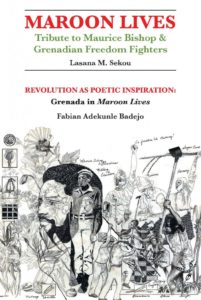
Writers Lasana Sekou and Fabian Badejo may only give cause for more questions with their revisit and treatment of the Grenada Revolution in the new title from House of Nehesi Publishers (HNP). However, the book includes color photos of extraordinary undersea sculptures by Jason deCaires Taylor that could definitely help a good many of us get an idea of art as inspirational and revolutionary.
The book is Maroon Lives – Tribute to Maurice Bishop & Grenadian Freedom Fighters by Lasana M. Sekou; Revolution As Poetic Inspiration: Grenada in ‘Maroon Lives’ by Fabian Adekunle Badejo.
Maroon Lives uses a collection of Sekou’s seminal poetry on revolution and a literary critique by Badejo to focus on the Grenada crisis of 30 years ago, with implications for today. Grenada, the Caribbean region and its Diaspora, had been deeply divided when Prime Minister Maurice Bishop, leader of the Grenadian Revolution, and his closest advisers were murdered by the country’s army on Oct. 19, 1983. Six days later, the U.S. executed its long-planned invasion of the Spice Isle.
According to Badejo, “the scars left by the assassination of the charismatic Maurice Bishop are yet to heal completely.” The 30th anniversary year of his death witnessed the passing of Bishop’s mother at age 97, without her ever receiving his remains from U.S. or Grenadian authorities for a proper burial.
Taylor’s sculptures in Maroon Lives were photographed between two and eight years ago on the ocean floor off the coasts of Cancun and Isla Mujeres, Mexico – one of the world’s largest sculpture museums underwater – and Moliniere Bay, Grenada. The latter site is part of a public underwater sculpture park, considered the world’s first.
People from one Meso-American fishing village modeled for the some 500 concrete human figures in various positions and activities for the location in the Mexican waters, according to the New York Times. Grenadian youth posed for one of the exhibits that appear in Maroon Lives. The installations populating the sea floor at both locations are by now covered with stunningly colorful coral and sea creatures.
“The sculptures form virtual vistas of living art that benefit nature and humanity by their creative, conservationist, and haunting integration with the marine habitats where they were sunk,” said Sekou.
The haunting aspect was probably the attraction for Maroon Lives’ integration of images from the uniquely permanent art exhibitions. The collection of poems “was and remains for me a dirge for a revolution gone bad; a revolution that held out the best hope for not only the Grenadian people, but for the whole of the Caribbean,” said Badejo.
The aspects of Maroon Lives that do celebrate life and hope are enhanced with the dramatic artwork from Taylor’s Caribbean and Mexican projects: “Vicissitudes,” “Tam CC project,” and the oft-photographed “Silent Evolution” and “The Lost Correspondent.”
Taylor, with maternal roots in the Caribbean region, is a conservationist. His undersea photography and skills as a scuba diving instructor have all come together to fashion the marine-grade concrete installations, works of art that stimulate “the habitation and growth of corals and marine life.”
With Taylor’s art gracing the 30th anniversary edition of Maroon Lives, HNP is continuing its own 30 years of featuring established masters and fascinating new artists on the covers and pages of its books. Romare Bearden, Roland Richardson, Virgilio Mendez, Fernando Botero, Ras Mosera, Keith Mallet, Drisana Deborah Jack, Angelo Rombley, Joe Dominique, Margaret Matz, Cozbi Sanchez, are among those whose art range from iconic to utterly captivating and have been “exhibited” in HNP titles. Sometimes the authors whose books have become galleries of sorts for these artists are themselves erudite scholars, literary luminaries, and revolutionaries: George Lamming, Amiri Baraka, Kamau Brathwaite, Chiqui Vicioso, Emilio Jorge Rodriguez.
The first edition of Maroon Lives contained drawings by Sanchez and Gary Jefferson—then young artists in New York City where the slim volume was published in 1983 (a few weeks after the Grenada invasion). Bishop’s classic likeness as the centerpiece of the new cover is actually a pen and ink drawing from the first edition.

Sekou offers this in his preface to the 96-page volume: “It is done in the hope that as ‘we journey still,’ the book will resonate with today’s protest poetry, related literary criticism, and dispatches from the culture wars and the challenges of globalization. It is certainly hoped that this tribute title would inform somehow the discourse and defiance of the enterprise of imperialism whatever shape, form, or guise this may take.”
Keith Ellis, professor emeritus at University of Toronto, is certain that Maroon Lives, as a “powerful extensive elegy that privileges revolution—like others by José Martí and Nicolás Guillén—will not grow old, nor will the brilliant essay by Fabian Adekunle Badejo that accompanies it.”
In the book’s first chapter, Sekou’s poems take aim at the Bishop assassination, the U.S. invasion, and tensions generated by revolutionary struggles and the search for justice. Chapter two is Badejo’s study of Maroon Lives and the critical relationship between literature, revolution, and the transformation of societies.
The images of the Taylor sculptures invite us to dive into the sections of chapter one; at the beginning of chapter two; and introduce the appendixes that open with a list over 60 invasions and other military operations by the U.S. against countries and territories in the Caribbean and the Americas, between 1833 and 2004.
The placement of the images appears to speak to a universal subterranean memory. They are like anchored gates opening and linking the various parts of the literary texts by the authors, and the leaves bearing quotes from Walter Rodney, Maurice Bishop, and a Puerto Rican newspaper editorial from 1894 about the ambitions of “The American neighbor.” The poetry sections of chapter one are entitled “resistance,” “forwarding” and “toiled from morning.”
Maroon Lives – Tribute to Maurice Bishop & Grenadian Freedom Fighters / Revolution As Poetic Inspiration: Grenada in ‘Maroon Lives’ is available at amazon.com, spdbooks.org, Van Dorp, Arnia’s and other bookstores.
-By Jacqueline Sample


